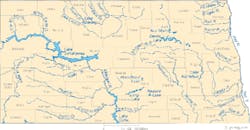DENVER, CO, JULY 24, 2017 -- The U.S. Environmental Protection Agency (EPA) has awarded $3,884,000 to the North Dakota Department of Health (NDDH) to help protect human health and the environment through a Nonpoint Source Program Clean Water Act Section 319 cooperative agreement. This grant is given to states to implement environmental programs that address nonpoint source pollution in surface and groundwater in order to meet and maintain water quality standards.
"Providing funds directly to North Dakota is an excellent example of EPA partnering with states to help address their unique and critical environmental challenges," said EPA Administrator Pruitt. "EPA is making investments like this grant to help empower states who know best how to protect resources, and grow their economy while solving real environmental problems in local communities."
Under this program, a total of nine proposals were selected including watershed implementation projects focused on soil erosion, livestock manure management, riparian grazing and nutrient management. Also included are projects designed to strengthen local watershed leadership, educate K-12 students and provide resource planning assistance to agricultural producers. The basic goal for all the projects is to improve water quality and restore the beneficial uses of waters impacted by nonpoint source pollution. The program works through a set of overarching principles that emphasize voluntary and incentive-based participation, locally-led projects, partnerships, measurable water quality improvement and effective and efficient program administration. For more information, visit https://go.usa.gov/xN7NF
Nonpoint sources of pollution continue to be recognized as the nation's largest remaining cause of surface water quality impairments. Nonpoint source pollutants causing the majority of impairments to North Dakota's lakes, rivers and streams are pathogens, sediment, and nutrients.
Nonpoint source pollution encompasses a wide range of sources that are not always subject to federal or state regulation. These sources include agricultural runoff, unpermitted urban runoff, abandoned mine drainage, failing onsite disposal systems, and pollution caused by changes to natural stream channels.
Congress enacted Section 319 of the Clean Water Act in 1987, establishing a national program to control nonpoint sources of water pollution. Through Section 319, the EPA provides states, territories, and tribes with guidance and grant funding to implement their nonpoint source programs and to support local watershed projects to improve water quality. Collectively this work has restored over 6,000 miles of streams and over 164,000 acres of lakes since 2006. Hundreds of additional projects are underway across the country.


